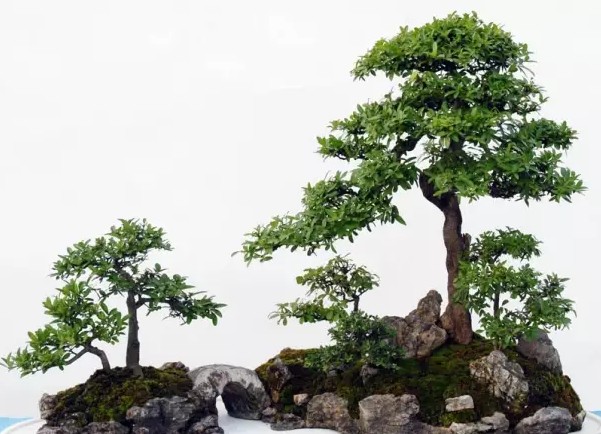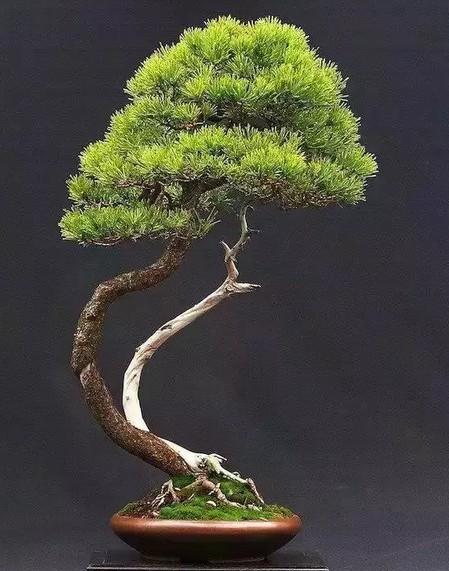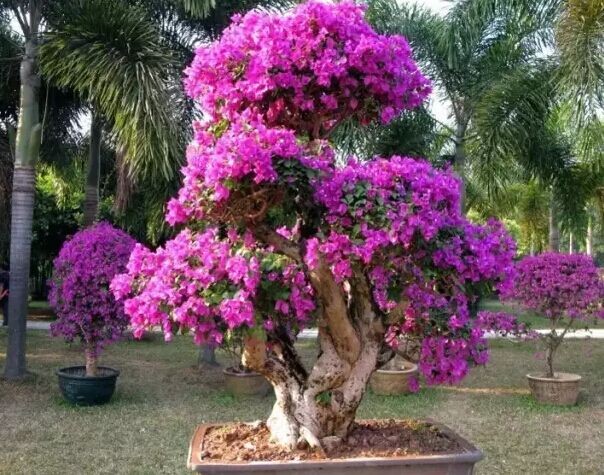The artistic principle of making bonsai
In the process of making bonsai, certain artistic principles should be followed. Only in this way can bonsai have infinite artistic charm.

1. Learn from nature and treat people according to their talents.
Bonsai represents the scene of nature, so it must conform to nature and conform to the laws of nature. Moreover, the materials used in bonsai, such as plants, mountains, stones, water, soil, etc., should have a certain natural form and color. Plants, in particular, have the characteristics of life. Therefore, when making bonsai, it should be treated according to the different properties of different materials. Such as pines and cypresses, it is appropriate to show the simple and vigorous style, but if you use it to express the graceful charm, you will fail.
2. A clear distinction between primary and secondary
None of the parts of any work of art can be equal. There must be a master and a time. In the creation of bonsai, certain measures must be taken to highlight the subject in order to enhance the appeal.
To highlight the main body, we should first determine the volume, position and shape of the main body, and then consider how to configure the ligand. Only in this way can we achieve harmony and unity as a whole. In addition, the position of the subject is also very important. Generally speaking, the main body should not be placed in the middle of the basin, nor should it be placed on the edge of the basin, but should be slightly biased to one side and placed in the visual center of gravity.
It can also highlight the main body through the comparison of volume, color, texture and other aspects. Like a small tree that is not too tall, you can highlight the height of the tree by placing a pony as an accessory. In terms of color, the main body uses a higher purity and brighter color, and the ligand sets off the main body with a slightly grayish color, which can serve as a foil to the main body. In addition, the principle of near big, far small, near clarity and far vagueness in the perspective relationship can be used to highlight the subject.
3. Deficiency and reality are born together, and they are properly sparse and dense.
In the creation of bonsai, emptiness and reality are both opposite and unified contradictions. Reality gives people support; emptiness gives people imagination. Virtual and real bonsai are very common. For example, in the landscape bonsai, the mountain is solid, the water is virtual, through the combination of mountain and water, such as the change of water shoreline, to achieve the goal of mutual growth of virtual and real. As far as the rock itself is concerned, the mountain is an entity, and in order to make it virtual, we dig holes in the mountain to attract waterfalls and plant trees. As far as water is concerned, water is a virtual body. in fact, pebbles or rafts can be placed in the water.
In bonsai creation, the combination of deficiency and reality also means that the elements of bonsai can not be evenly distributed. Arrange it rhythmically and rhythmically. Use sparse and dense changes to show emptiness and reality.
4. Look forward to echoing
The elements in bonsai, such as trees, rocks, water and dry land, do not exist in isolation, whether they are primary or secondary, virtual or real, gathering or scattered. Therefore, in the creation, each component must have a certain echo to make it an organic whole. Looking forward to echo is reflected in many aspects of bonsai. For example, in the direction of the movement of the scenery, it is necessary to achieve an overall sense of consistency in terms of type, shape, lines, color, texture, emptiness, density, weight, and so on. If in the production of landscape bonsai, the main peak should be mainly a straight line, then the peak should also be a straight line to echo it. For example, if there is a certain color in the main scene, it is also necessary to have this color in the matching scene in order to achieve a consistent feeling as a whole.
5. Hide in the dew
The ancients said, "the more the scene is hidden, the bigger the realm is, and the more exposed the scene is, the smaller the realm is." Therefore, in the creation of bonsai, properly hiding a part can show a great realm in a very small range, and can arouse people's endless imagination, in order to achieve the deep meaning of creation. For landscape bonsai, hiding in the dew is to hide the peaks from each other in order to enrich the layers and increase the depth of field. If you want to show the depth of the trees, we should pay attention to the trees, before and after the trunk interspersed with each other, there are exposed and hidden. Revealing and hiding is an important means to express the artistic conception of bonsai, so we should pay attention to its application.
6. Clever and clumsy interoperability
Dexterity, that is, dexterity; clumsiness, refers to sincerity, elegance. Cleverness and clumsiness can also give people a sense of beauty. In bonsai trees, the more clumsy the posture of trees, the more aesthetic they can give people. For example, plum blossom, the flower itself is flexible and elegant, so its trunk must be vigorous and simple. In order to reflect its rich charm. In the landscape bonsai, if the mountain is majestic and deep, the trees on the mountain must be exquisite and form a clumsy contrast with the mountain.
7. "Sanyuan" method
The "Sanyuan" method is the basic theory of Chinese painting art. According to people's point of view, it can be divided into looking up high and far, looking down far-reaching, and looking flat. In the production of bonsai, we should strive to show "Sanyuan".
The Gao Yuan method can show the abrupt and straight trend of the main peak. To create lofty landscape bonsai, the main peak should be high and steep, the position should be partial, from the bottom up, and gradually become smaller. The matching peak is in front of or around the main peak, should be low before and after high, high and low. The texturing pattern of the rock should be clear, and the water surface should be smaller.
The deep and distant method is used to show the beauty of overlapping peaks and overlapping mountains and rivers. Generally speaking, there should be a staggered combination of near and distant mountains, so we must properly deal with the relationship between "dew" and "Tibet" so as to make the whole bonsai have a deep feeling. Generally speaking, the texturing pattern near the mountain should be clear, the texturing pattern in the distant mountain is gradually plain, and the size of the water surface should be moderate.
Pingyuan method, the performance of a typical water atmosphere, the pursuit of a flickering, ethereal realm. Pingyuan style landscape bonsai, usually low and gentle peaks, long and horizontal mountain shape, plain textured lines, tortuous waterfront, broad water surface, leaving more white.
8. Appropriate proportion
In the theory of Chinese painting, there is the theory that "Zhangshan foot tree inch horse is divided into people", which reflects the proportional relationship between the various scenes in bonsai production. If we deal with the proportional relationship between the scenery reasonably, we can show the broad scenery in the small pot and get the big effect in the small bowl. For example, the performance of a peak with a small stone the size of a fist, if set alone, is too small. If it can be lined with a figure the size of a soybean, the stone will feel as high as a mountain, tall and straight.
9. Love lies in the scene
Bonsai is a lyric art of borrowing scenery. Excellent bonsai can not only reproduce the natural beauty, but also arouse the emotional resonance of the viewer. Therefore, in the production of bonsai, one mountain, one river, one tree and one grass should infiltrate into the author's feelings and agglomerate the author's feelings, so that the viewer can not only see the scenery in the basin, but also experience the feelings in the scene.
Time: 2019-05-23 Click:
- Prev

The Beauty of Bonsai Art
China is the poetry kingdom of the world. Poets of all ages have a special fondness for flowers and trees. With condensed language and vivid words, they vividly summarize the spiritual character and amorous feelings of landscape flowers and trees, as well as the art of chanting bonsai. The smoke is green in three autumn colors, and the waves are immortal. Cut into clear jade slices and truncate Biyungen
- Next

How to appreciate the beauty of bonsai
Everyone knows that a good bonsai looks good, but how to enjoy it? Bonsai as a work of art, how to appreciate, is not a simple matter. It requires the viewer to have a certain ideological level, cultural and artistic accomplishment and life experience. As the saying goes: amateurs watch the hustle and bustle, experts watch the way
Related
- Fuxing push coffee new agricultural production and marketing class: lack of small-scale processing plants
- Jujube rice field leisure farm deep ploughing Yilan for five years to create a space for organic food and play
- Nongyu Farm-A trial of organic papaya for brave women with advanced technology
- Four points for attention in the prevention and control of diseases and insect pests of edible fungi
- How to add nutrient solution to Edible Fungi
- Is there any good way to control edible fungus mites?
- Open Inoculation Technology of Edible Fungi
- Is there any clever way to use fertilizer for edible fungus in winter?
- What agents are used to kill the pathogens of edible fungi in the mushroom shed?
- Rapid drying of Edible Fungi

